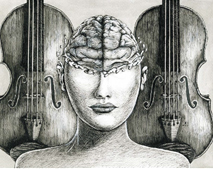Structural and functional interaction in music and monetary reward processing
Music is ranked amongst the highest sources of pleasure and is ubiquitous in all human societies. Despite this, not everybody loves music. Recent work by Mas-Herrero and colleagues has uncovered that approximately 3-5% of the population does not derive pleasure from music but are otherwise normal in terms of general reward sensitivity and have no difficulties in music perception or emotion recognition. These authors also reported a dissociation between music and monetary reward (skin conductance response, heart rate) in people with specific musical anhedonia. These new insights raised many intriguing questions, especially: what are the functional and structural neural basis of individual differences in music reward processing? In this thesis, we addressed this question by combining fMRI and DTI techniques in three groups of 15 participants, each with different sensitivity to music reward.
In the first study, we demonstrated that the music anhedonic participants showed selective reduction of activity for music in the nucleus accumbens (NAcc), but normal activation levels for a monetary gambling task. Furthermore, this group also exhibited decreased functional connectivity between the right superior temporal gyrus (STG) and ventral striatum (including the NAcc). In contrast, individuals with greater than average response to music showed enhanced connectivity between these structures. In support of previous findings, our results suggest that specific musical anhedonia may be associated with a reduction in the interplay between the auditory cortex and the subcortical reward network, indicating a pivotal role of this interaction for the enjoyment of music.
The second study of this dissertation was designed to investigate the microstructural signatures of individual differences in music reward processing. In particular, we performed a tractography reconstruction of the structural connectivity that could be mediating the complex interactions between cortical and subcortical systems in rewarding responses to music. More specifically, we dissected the tracts communicating the STG with the NAcc through the orbitofrontal cortex (OFC). In line with the hemispheric specialization hypothesis and functional connectivity evidence, we found that white matter properties of the pathway connecting the right STG and the OFC inversely correlated with the sensitivity to musical reward. Additionally, white matter properties of the pathway connecting OFC and NAcc also showed an inverse correlation with music reward sensitivity. These relationships were not related to general anhedonia or overall sensitivity to reward and punishment. Further, white matter architecture between OFC and NAcc also correlated bilaterally with the BOLD activity for musical but not for a control monetary reward task in the NAcc.
Overall, the findings from this thesis lend support to the notion that the interactions between perceptual, integrative and reward systems are crucial in order to experience pleasure from music listening. The disruption of the flow of information between these regions may help to explain the lack of music reward sensitivity observed in people with specific musical anhedonia. Importantly, not only could this broaden our understanding of the neurobiology of music reward but also guide future studies on specific anhedonias (and hyperhedonias) in other domains.

